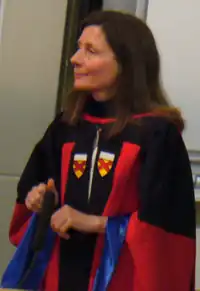Patricia Burchat | |
|---|---|
 | |
| Born | Patricia Rose Burchat 1958 Ontario, Canada |
| Occupation | Professor of Physics |
| Spouse | Tony Norcia |
| Children | 2 |
| Awards | Fellow, American Association for the Advancement of Science Fellow, American Physical Society Gabilan Professor of Physics Guggenheim Fellow |
| Academic background | |
| Education | B.S., University of Toronto Ph.D., Stanford University |
| Thesis | Decays of the Tau Lepton (1986) |
| Doctoral advisor | Gary Feldman |
| Academic work | |
| Discipline | Physicist |
| Sub-discipline | Experimental high energy physics Astrophysics |
| Institutions | Stanford University |
| Notable students | Stephanie A. Majewski |
| Website | physics |
Patricia Burchat (born 1958) is the Gabilan Professor of Physics at Stanford University who researches experimental particle physics and cosmology. She is interested in mapping dark matter in the universe, and understanding the nature of dark energy.[1] She was named a fellow of the American Physical Society in 2001, and a Guggenheim Fellow in 2005.[2][3] In 2013 she became a fellow of the American Association for the Advancement of Science.[4]
Early life and education
Born in 1958, Burchat grew up in Barry's Bay, Ontario, Canada, and attended Madawaska Valley District High School.[5] In 1981 she graduated with a B.S. in applied science and engineering from the University of Toronto, and earned a Ph.D. in physics at Stanford University in 1986.[6]
Career
Burchat held a postdoctoral fellowship at the University of California, Santa Cruz from 1986 to 1988, after which she joined the faculty until 1995.[7] She has been a member of the Stanford Physics faculty since 1995,[7] and served as the chair of the department from 2007 to 2010.[8]
Research
Burchat has been a member of multiple particle physics experiments, including the Mark II experiment at the SLAC Linear Collider and the E791 experiment at Fermilab. She was a founding member of the BaBar experiment at SLAC[6] which explored fundamental particle interactions, especially the weak interaction. In these experiments she researched Z bosons as the carriers of the weak interaction, heavy neutral leptons, semileptonic decay of charm mesons, charm mixing, CP violations in B meson decays, and differences in the way matter and antimatter evolved in time.[6]
Burchat has also been interested in investigating the cosmological evolution of the Universe. She joined the international community developing the Large Synoptic Survey Telescope, aiming to study gravitational bending of light by dark matter and the evolution of dark energy.[9] Her 2008 TED talk, "Shedding light on dark matter", explores these two components making up about 96 percent of the universe.[10]
See also
References
- ↑ "Patricia R. Burchat - The Clayman Institute for Gender Research". gender.stanford.edu. Retrieved May 26, 2016.
- ↑ "Patricia Burchat - Array of Contemporary American Physicists". www.aip.org. Archived from the original on August 12, 2016. Retrieved June 25, 2016.
- ↑ "John Simon Guggenheim Foundation. - Patricia Burchat". www.gf.org. Retrieved May 26, 2016.
- ↑ "Professor Patricia Burchat named Fellow of the American Association for the Advancement of Science. | Department of Physics". physics.stanford.edu. Retrieved June 23, 2016.
- ↑ Glynn, Kate (April 4, 2012). "Searching for the secrets of the universe". The Valley Gazette. Archived from the original on September 20, 2021. Retrieved March 16, 2023.
- 1 2 3 "Profile, Patricia Burchat". Stanford University. Retrieved June 23, 2016.
- 1 2 "Burchat, Patricia Rose - Profile - INSPIRE-HEP". inspirehep.net. Retrieved June 24, 2016.
- ↑ "People - Patricia Burchat". Stanford University - School of Humanities and Sciences. Retrieved June 23, 2016.
- ↑ "Patricia Burchat - Department of Physics". physics.stanford.edu. Archived from the original on September 11, 2017. Retrieved June 24, 2016.
- ↑ Burchat, Patricia (February 2008), Shedding light on dark matter, retrieved June 24, 2016.